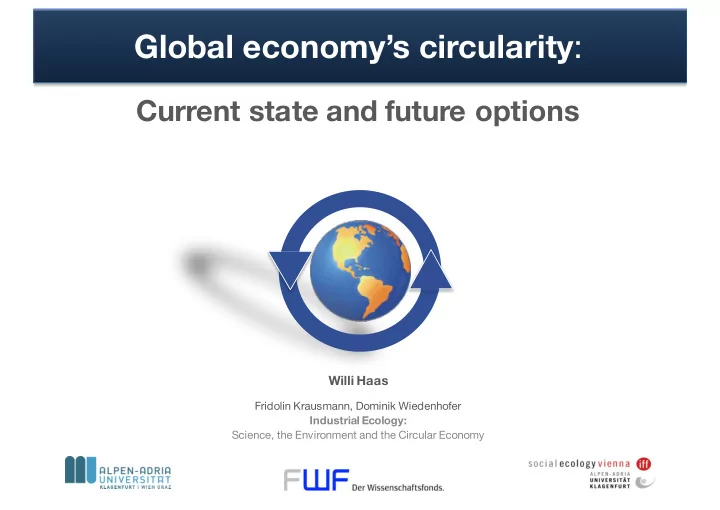

Global economy’s circularity : Current state and future options Willi Haas Fridolin Krausmann, Dominik Wiedenhofer Industrial Ecology: Science, the Environment and the Circular Economy
Introduction: Promising cases at industry and national scale Remanufactured part Appliance recycling Symbiosis Programme at company level laws recovered port facilites o What is the o How circular is potential? the economy o What are the (system level)? limitations? Global economy Input Output Source: Krausmann et al. 2009 Source: Rockstroem et al. 2009 Environment
Defining the Circular Economy A Circular Economy (CE) is based on two resource loops (GEO5 2012): Global economy Conditions Ouput Input materials designed to circulate within the • effective reduction socioeconomic system of virgin material (reuse, re-manufacturing and recycling) • carbon neutral energy use • biomass produced biological materials, which after discard in a renewable way are available for ecological cycles • no net carbon emissions difficult to assess these criteria – our results rather show the upper range
EU27 Material Flows in Gt in 2005 EU27 3.1 Ores Fossils Biomass Minerals Domestic processed output 19 1.9
Circular economy indicators in the EU and for the world Materials processed: 16 38% 37% 10 10 6 13% 7% EU27 has slightly higher degree of but also higher rates of circularity due to much higher per capita material inputs and recycling shares waste output
Crucial points towards a circular economy Materials processed Total: 62 Gt Energetic use & Processed Stock additions Energetic Addition Energetic Material materials use to stocks use = 89% use 46% 43% 46% = 7.7 Gt 54% Waste rock Short lived products 2% 9%
Crucial points towards a circular economy Potential degree of circularity: 38% Biomass* ) and recycled biological NAS material materials** ) as share of 22% Processed 25% materials materials processed But 62% (4,5 = 7.7 Gt techn. * ) Assumption: (1) biomass Gt/yr) no loop Recycling throughput produced in a renewable way (soil, 13% closing 40% water, carbon); (2) All biomass waste flows re-enter ecological cycles ** ) Assumption: no down-cycling
Crucial points towards a circular economy Downscale European Reduce share of fossils -> metabolism • increase renewables Materials processed Total: 62 Gt • ensure sustainable production and use of biomass Increase EoL recycling -> • define targets for recycling rates Stock growth • take into account: limits recycling -> o spatial distribution of • legacy effect stocks and production • stabilize or o technology gap reduce the size prod/recycl, downcycling of stocks and thermodynamic limitations
Conclusions: Potentials, limits and policies • Closing Raw DPO Recycling What-if analysis materials / loops: materials Requires modelling reference 2005 6,7 5,0 13% reference 2005 6,7 5,0 13% of linkages 20% higher recycling rate 6,5 4,8 15% 20% higher recycling rate 6,5 4,8 15% between flows and 50% Decarbonisation 5,7 4,1 14% 50% Decarbonisation 5,7 4,1 14% stocks and flows 50% Addition to stocks 5,1 5,0 16% 50% Addition to stocks 5,1 5,0 16% combined 4,2 4,5 22% 4,2 4,5 -38% -20% • Increasing loop closing (within economy) from 13 to 22% and reducing raw material input by 38% is a big challenge. • This needs a two-dimensional policy integration for • Fossil energy I O tackling the resource • Biomass • Metals nexus Stocks • Construction minerals • Even high circularity needs outputs to stay within planetary boundaries • Growing stocks determine high flow levels today and in future • Shrinking flows and stabilizing stocks remains a major policy challenge
Thank you for your attention The long and bumpy way to a circular economy
Recommend
More recommend